Symbols For Process Flow Diagrams And Engineering Line Diagrams
Author: Tammy Wong [2015]
Stewards: Jian Gong and Fengqi You
Contents
- 1 Introduction
- 2 Overview
- 3 Categorization of Information In a Process Flow Diagram
- 4 Process Topology
- 4.1 Process Vessels and Equipment
- 4.2 Symbols for Process Technology
- 4.3 Symbols for Heat Exchanger Equipment
- 4.4 Symbols for Fluid Handling Equipment
- 4.5 Utility Streams in Process Topology
- 5 Stream Information
- 6 Equipment Information
- 6.1 Naming Equipment
- 6.2 Examples of Equipment Summary Tables
- 7 Process Flow Diagram Example
- 7.1 Example 1: Polymer Production
- 7.2 Example 2: Simplified Nitric Acid Process
- 8 Conclusion
- 9 Sources
Introduction
The process flow diagram (PFD) is a critical component of process design. It is absolutely necessary that chemical engineers know how to read process flow diagrams because it is the primary method of detailing the process and design information. Additionally, the most effective way of relaying information about a process design is the use of process flow diagrams. The PFD shows the sequence of flow through a system through the various equipment (such as piping, instrumentation, and equipment design) and details the stream connections, stream flow rates and compositions and operating conditions through the plant layout. The PFD differs from a block flow diagram (BFD) in that the PFD is more detailed and conveys more information than the BFD, which only gives a general sense of flow of information.
Overview
On the process flow diagram, there are several pieces of information that must be included while there are some optional information that can be included to make the PFD more specific. Notable information that should be included should be major process equipment and followed by a short description. Additionally, each piece of equipment should be named and listed on a table along with a description of the name. For more details on how to name process equipment, see "Naming Equipment". On the process flow diagram, all streams should be labeled and identified with a number. A summary of the streams and their numbers should also be detailed on a separate table. All utility streams that supply energy to major equipment should be shown. In Table 1, other types of essential information to the process flow diagram as well as the optional information that could be supplied to further detail the process are listed.
| Essential Information |
|
|---|---|
| Optional Information |
|
Categorization of Information In a Process Flow Diagram
The information that a process flow diagram conveys can be categorized into one of the following three groups. Each of the three aspects will be discussed in more details.
- "Process Topology"
- "Stream Information"
- "Equipment Information"
Process Topology
Process topology is defined as the interactions and locations of the different equipment and streams. It includes all of the connections between the equipment and how one stream is changed to another after it flows through a piece of equipment. On a separate table, following the process flow diagram, the equipment must be labeled (see "Naming Equipment") and followed by a short description so that the engineer who is trying to understand the process flow will have a easier time following. The following sections will describe how to catalog the necessary information for the equipment of the process topology.
Process Vessels and Equipment
One of the initial steps to creating a process flow diagram is to add all of the equipment that is in the plant. Not only is the major equipment, such as distillation columns, reactors, and tanks, necessary to be shown in a PFD, so is the equipment such as the heat exchangers, the pumps, reactors, mixers, etc). The following figures will display the most common symbols found in process flow diagrams.
Symbols for Process Technology
For process equipment, there are a few standard symbols that should be recognized by chemical engineers. Typically, these symbols correlate to the ones on the Microsoft Visio Engineering package that can be used to create process flow diagrams. In the next few sections, the figures will display various symbols that are used for the process flow diagrams. Figure 1 (Towler and Sinnott, 2013) displays typical process equipment - notables ones that should be recognized because they are relevant to this class are the symbols for the vertical and horizontal vessel, the packed column and the trayed column. For the typical information that follows the process equipment, refer to "Equipment Information".
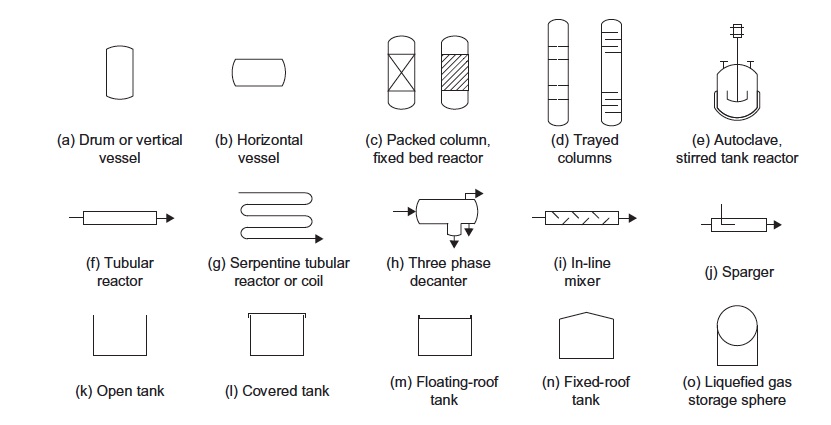
Figure 1: Various symbols for reactors, vessels and tanks (Towler and Sinnott, 2012)
Symbols for Heat Exchanger Equipment
In addition to the process equipment symbols, there will be heat exchanger equipment that are essential to process flow diagrams. Notable symbols that are relevant to this class include the basic heat exchanger symbols, the shell and tube exchangers, the kettle reboiler, the U-tube exchanger, and heating coils. Other heat exchanger equipment are listed in Figure 2. (Towler and Sinnott, 2013) Typical information that follows heat exchanger equipment are the utility streams that enter and exit the heat exchanger, the pressures, temperature, and the duties.
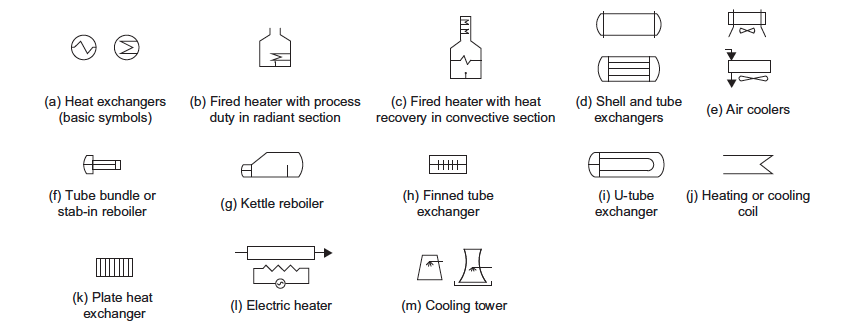
Figure 2: Various symbols for heat exchanger equipment (Towler and Sinnott, 2013)
Symbols for Fluid Handling Equipment
In a process, some streams may have difficulty moving from one process equipment to another. Therefore, the placement of fluid handling equipment in between streams can help facilitate this process. In Figure 3 (Towler and Sinnott, 2013), various symbols are displayed for fluid handling equipment. Notable equipment that we will use for this class include the centrifugal pumps, axial or centrifugal compressor, and the turbine. In addition to placing this equipment on the process flow diagrams, a separate table should list the name of this equipment, a description of the type of equipment, and the amount of power supplied to the machinery.
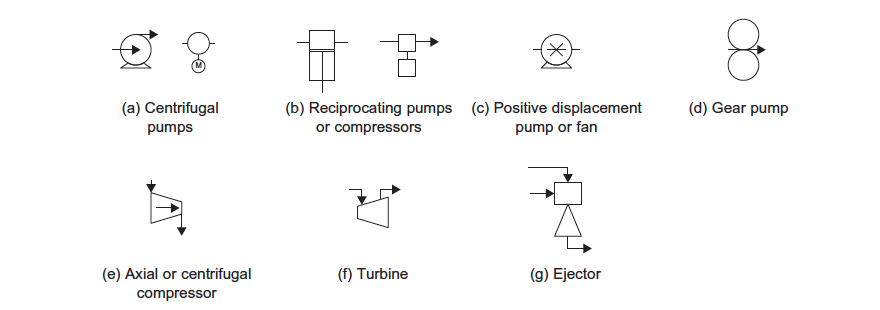
Figure 3: Various symbols for fluid handling equipment (Towler and Sinnott, 2013)
Utility Streams in Process Topology
Utilities are necessary for the plant to keep running. The purpose of the utilities is usually to add or remove heat to the equipment so that the temperature can be controlled. The type of utility for the duties should also be specified on a separate table following the process flow diagram. One way to find the type of utility that is supplied can be done in HYSYS where the process must first be modeled and then sent to the heat exchanger analyzer. The following bullet points are examples of the many different types of utilities that can service a plant:
- Electricity
- Compressed Air
- Cooling Water
- Refridgerated Water
- Steam
- Condensate Return
- Inert Gas
- Flares
The following table lists the initials that are typically found on a PFD followed by a description/definition of the initial.
| Initials of the Utility Stream | Description of the Initial |
|---|---|
| lps | Low-Pressure Steam (3-5 barg) |
| mps | Medium-Pressure Steam (10-15 barg) |
| hps | High-Pressure steam (40-50 barg) |
| htm | Heat Transfer Media (Organic) |
| cw | Cooling Water |
| wr | River Water |
| rw | Refrigerated Water |
| rb | Refrigerated Brine |
| cs | Chemical Waste Water with high COD |
| ss | Sanitary Waste Water with high BOD |
| el | Electric heat |
| ng | Natural Gas |
| fg | Fuel Gas |
| fo | Fuel Oil |
| fw | Fire Water |
Stream Information
Streams should be labeled so that they follow consecutively from left to right of the layout so that it is easier to follow along and locate numbers when you are trying to locate streams listed on the tables. For large processes, the designers of the flowsheet may have a system - for example, the streams in the 100 series may be named for the feed preparation section, the streams in 200 series may be for the reaction, in the 300 series, it may be used for separation and in the 400 series, it may be used for purification. This is especially useful when there is a lot of information and it can help the user of the process flow diagram locate the specific section faster.
In small PFDs, stream information, including flow rates, temperatures, pressures, and compositions, are shown directly next to the PFD on a table. The corresponding number on the stream will be translated onto the table. The following table shows a typical table that details stream information; it usually divided into two sections - one section for the essential information and one for the optional information.
| Essential Information |
|
|---|---|
| Optional Information |
|
For a larger PFD, it is essential to list the stream name on the first row and the essential information about the stream on the first column. This table is usually located below the process flow diagram for easy access and reference.
| Stream Number | 1 | 2 | 3 | 4 | 5 | 6 | 7 | 8 |
|---|---|---|---|---|---|---|---|---|
| Temperature (Celsius) | 30 | 49 | 88 | 23 | 143 | 222 | 133 | 300 |
| Pressure (bar) | 33 | 22 | 21 | 25 | 50 | 66 | 90 | 78 |
| Vapor Fraction | 0 | 1 | 0 | 0 | 1 | 1 | 1 | 0 |
| Mass Flow (kg/hr) | 10 | 16 | 20 | 22 | 38 | 45 | 33 | 22 |
| Mole Flow (kmol/hr) | 23 | 50 | 100 | 123 | 24 | 28 | 55 | 18 |
| Hydrogen Mole Flow (kmol/hr) | 0 | 25 | 25 | 23 | 2 | 4 | 50 | 6 |
| Methane Mole Flow (kmol/hr) | 23 | 25 | 25 | 50 | 20 | 12 | 5 | 6 |
| Benzene Mole Flow (kmol/hr) | 0 | 0 | 50 | 50 | 2 | 12 | 0 | 6 |
Equipment Information
In addition to the stream information, there should also be a table detailing equipment information. This table can be helpful for the economical analysis of the plant because it should provide the information necessary to estimate the cost of the equipment. The equipment information table should include a list of all of the equipment that is used in that particular flow diagram along with a description of size, height, number of trays, pressure, temperature, materials of construction, heat duty, area and other critical information.
Naming Equipment
Typical names for the equipment include a letter followed by a set of numbers. The letter usually corresponds to the first letter of the equipment. For example, the first pump in the PFD is typically labeled P-101. The following table displays the convention of naming the letters for process equipment:
| Initials of the Equipment | Description of the Equipment |
|---|---|
| C | Compressor or Turbine |
| E | Heat Exchanger |
| P | Pump |
| R | Reactor |
| T | Tower |
| TK | Storage Tank |
| V | Vessel |
| Y | A Designated Area of the Plant |
| A/B | Identifies parallel units or backup units |
Additionally, it should be noted that in a plant, certain equipment will need to be replaced. Typically, the new equipment will take the old equipment's name but an additional letter or number will be added onto the new equipment to indicate that there was a modification.
Examples of Equipment Summary Tables
In the following table, an equipment summary is provided for a toluene hydrodealkylation process flow diagram. Note that the equipment summary table is divided up into the respective type of equipment and the essential data that goes with each piece of equipment. For example, for the heat exchangers, duties, materials of constructions and area are types information that are essential because it can help with the economic evaluation. For vessels, reactors and towers, it is essential to include the size, materials of constructions, and temperature/pressures. For pumps, flow through it can help determine values for the economic evaluation.
| Heat Exchangers | E-101 | E-102 | E-103 | E-104 |
|---|---|---|---|---|
| Type | Floating Head | Floating Heat | Multiple Double Pipe | Floating Heat |
| Area (m^2) | 200 | 25 | 90 | 30 |
| Duty (MJ/hr) | 14,249 | 3,093 | 4,786 | 55 |
| Shell | ||||
| Temperature (Celsius) | 333 | 45 | 67 | 90 |
| Pressure (bar) | 35 | 140 | 45 | 120 |
| Phase | Partially Condensed | Condensed | Vapor | Condensed |
| Materials of Construction | CS | CS | 304SS | 304SS |
| Tube | ||||
| Towers | T-101 | T-102 | T-103 | T-104 |
| Temperature (C) | 24 | 267 | 300 | 345 |
| Pressure (bar) | 123 | 36 | 356 | 78 |
| Orientation | Horizontal | Vertical | Horizontal | Vertical |
| Materials of Construction | 316SS | CS | 304SS | CS |
| Height (m) | 4.5 | 5.9 | 10.6 | 4.9 |
| Diameter (m) | 5.5 | 6.4 | 2.3 | 3.3 |
| Pumps | P-101 | P-102 | P-103 | P-104 |
| Flow (kg/hr) | 1224 | 2226 | 3457 | 3488 |
| Fluid Density (kg/m^3) | 300 | 456 | 975 | 457 |
| Power (kW) | 456 | 7899 | 678 | 5678 |
| Type | Centrifugal | Centrifugal | Explosion Proof Motor | Centrifugal |
| Material of Construction | CS | CS | CS | CS |
| Efficiency | .90 | .55 | .66 | .88 |
Process Flow Diagram Example
Example 1: Polymer Production
Combining all of the information from the previous sections, we can now create and understand a full process flow diagram. In the following figure about polymer production (Towler and Sinnott, 2013), the PFD contains a few pieces of equipment so that the corresponding streams can be placed on the figure itself instead of on a separate table. Please note that all streams are labeled with the temperature, the flow rate and amount of each composition, and on a separate table, all of the equipment is clearly defined with their names. One improvement that can be made to this PFD is to be more detailed in the separate table and to include a description of the equipment.
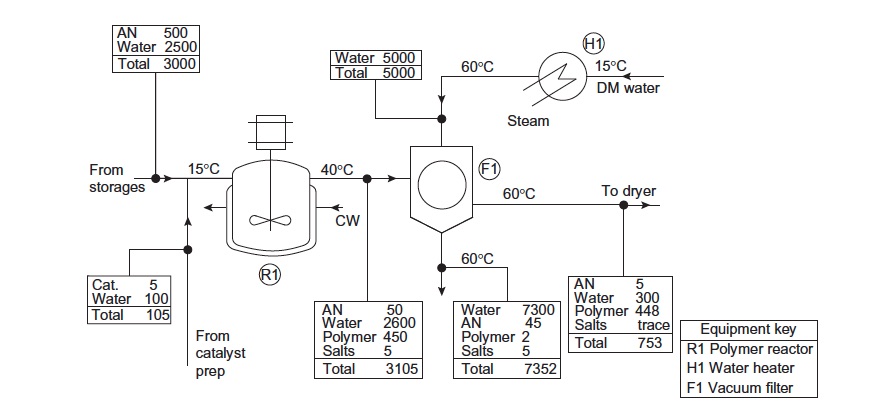
Figure 4: Process Flow Diagram Documenting Polymer Production (small process) (Towler and Sinnott, 2013)
A new process flow diagram was created in order to avoid the clutter of this first process flow diagram. Note that the streams that are labeled are just the numbers, with their stream information detailed in a separate table (Table 7).

Figure 5: Revised Process Flow Diagram Documenting Polymer Production (Towler and Sinnott, 2013)
| Stream Number | 1 | 2 | 3 | 4 | 5 | 6 | 7 |
|---|---|---|---|---|---|---|---|
| Temperature (Celsius) | 15 | 15 | 40 | 60 | 60 | 60 | 15 |
| Total Flow | 3000 | 105 | 3105 | 753 | 7352 | 5000 | 5000 |
| AN Mole Flow | 500 | 0 | 50 | 5 | 45 | 0 | 0 |
| Water Mole Flow | 2500 | 100 | 2600 | 300 | 7300 | 5000 | 5000 |
| Polymer Mole Flow | 0 | 0 | 450 | 448 | 2 | 0 | 0 |
| Salt Mole Flow | 0 | 0 | 5 | 0 | 5 | 0 | 0 |
| Cat Mole Flow | 0 | 5 | 0 | 0 | 0 | 0 | 0 |
However, not all process flow diagrams are as simple as the previous example. In fact, many are complicated processes that may span multiple pages. Therefore, a better example would be the following one.
Example 2: Simplified Nitric Acid Process
In Figure 5 (Towler and Sinnott, 2013), air enters a filter while ammonia enters a vaporiser to eventually combine in a reactor and form nitric acid. Each stream is labeled with a number and the compositions of the streams are labeled in a separate table. Additionally, in the separate table that follows directly below the PFD (standard convention), the pressures and temperatures of the streams are also listed. The one improvement on this PFD that can be made is to name the equipment with the nomenclature detailed in "Naming Equipment" and define those names on a separate table instead of writing the name of the equipment on the PFD. This way, there is less clutter on the PFD and it may be easier to follow along when all the names of the equipment are placed on the same table.
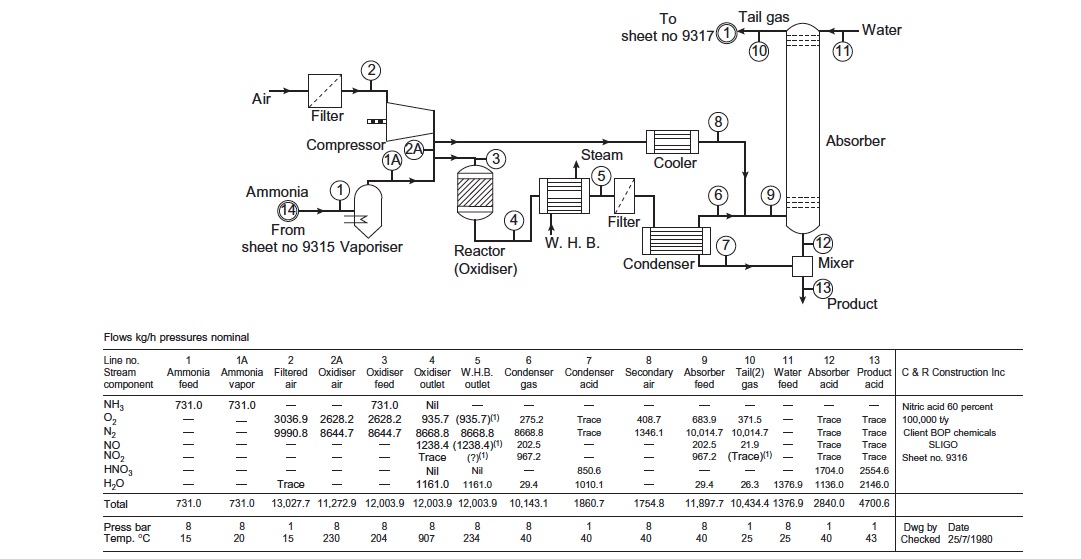
Figure 6: Process Flow Diagram Detailing the Nitric Acid Process (Towler and Sinnott, 2013)
Conclusion
The process flow diagram is an essential part of chemical engineering. It conveys a process and the path of its individual components - therefore, it is essential to learn how to read and create one. The process flow diagram is divided into three sections: process topology, stream information, and equipment information. The more detailed these three sections are, the easier it is for a user of the process flow diagram to follow along and understand.
Sources
- Towler G, Sinnott R. Chemical Engineering Design: Principles, Practice and Economics of Plant and Process Design. 2nd ed. Boston: Elsevier; 2013.
- Turton R, Bailie RC, Whiting WB, Shaeiwitz JA. Analysis, Synthesis, and Design of Chemical Processes. 2nd ed. New Jersey: Prentice Hall; 2003.
Source: https://processdesign.mccormick.northwestern.edu/index.php/Process_flow_diagram
Posted by: zeldazeldabrodkae0270763.blogspot.com
Post a Comment for "Symbols For Process Flow Diagrams And Engineering Line Diagrams"